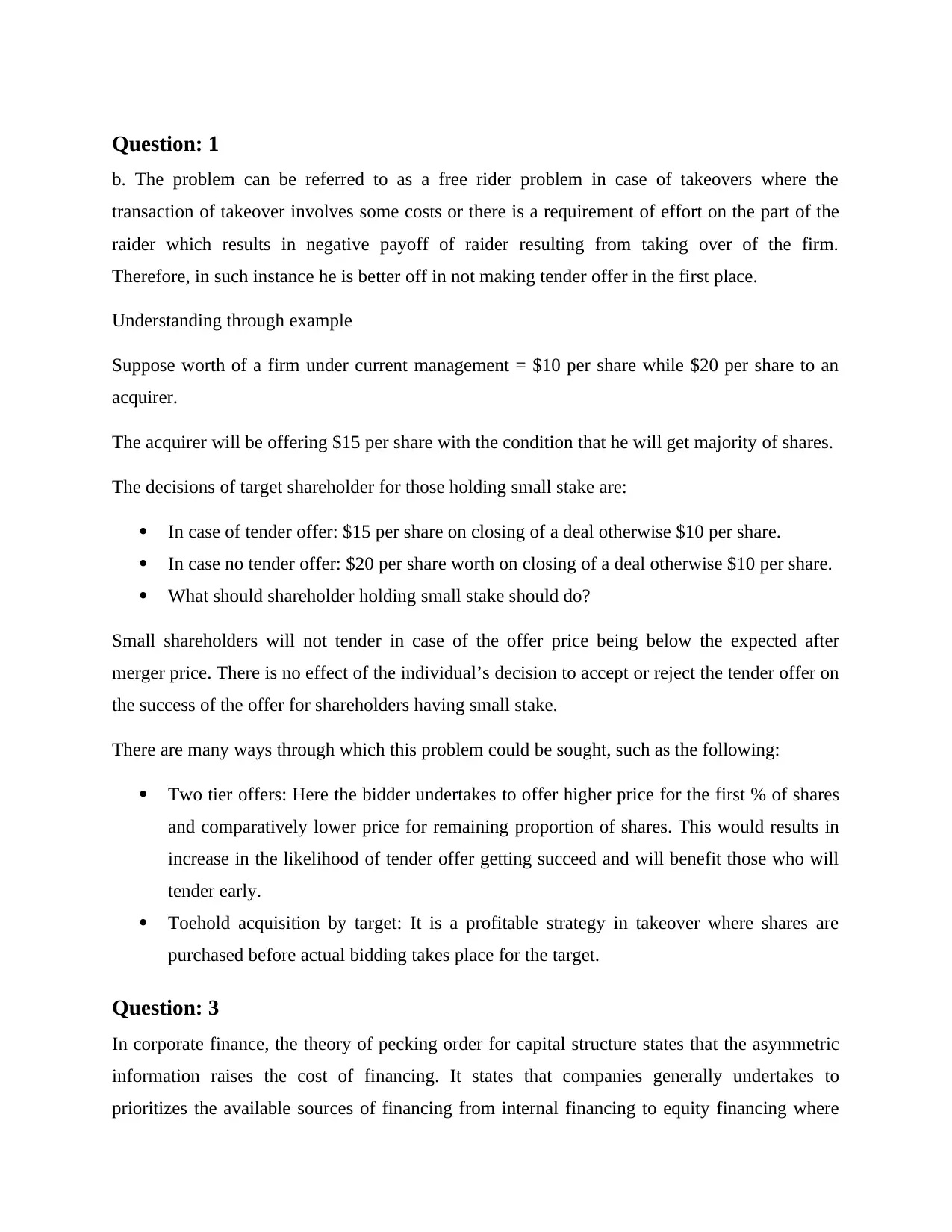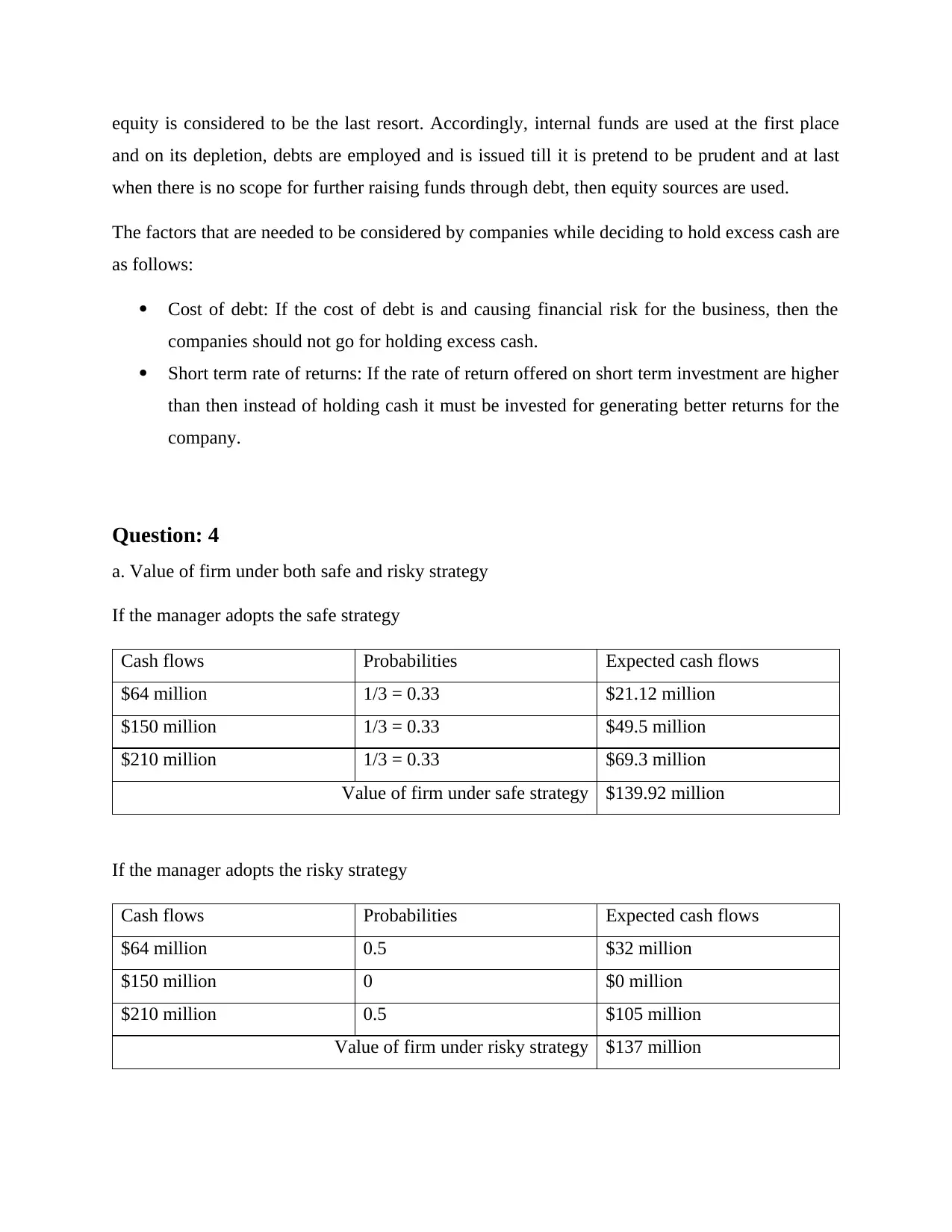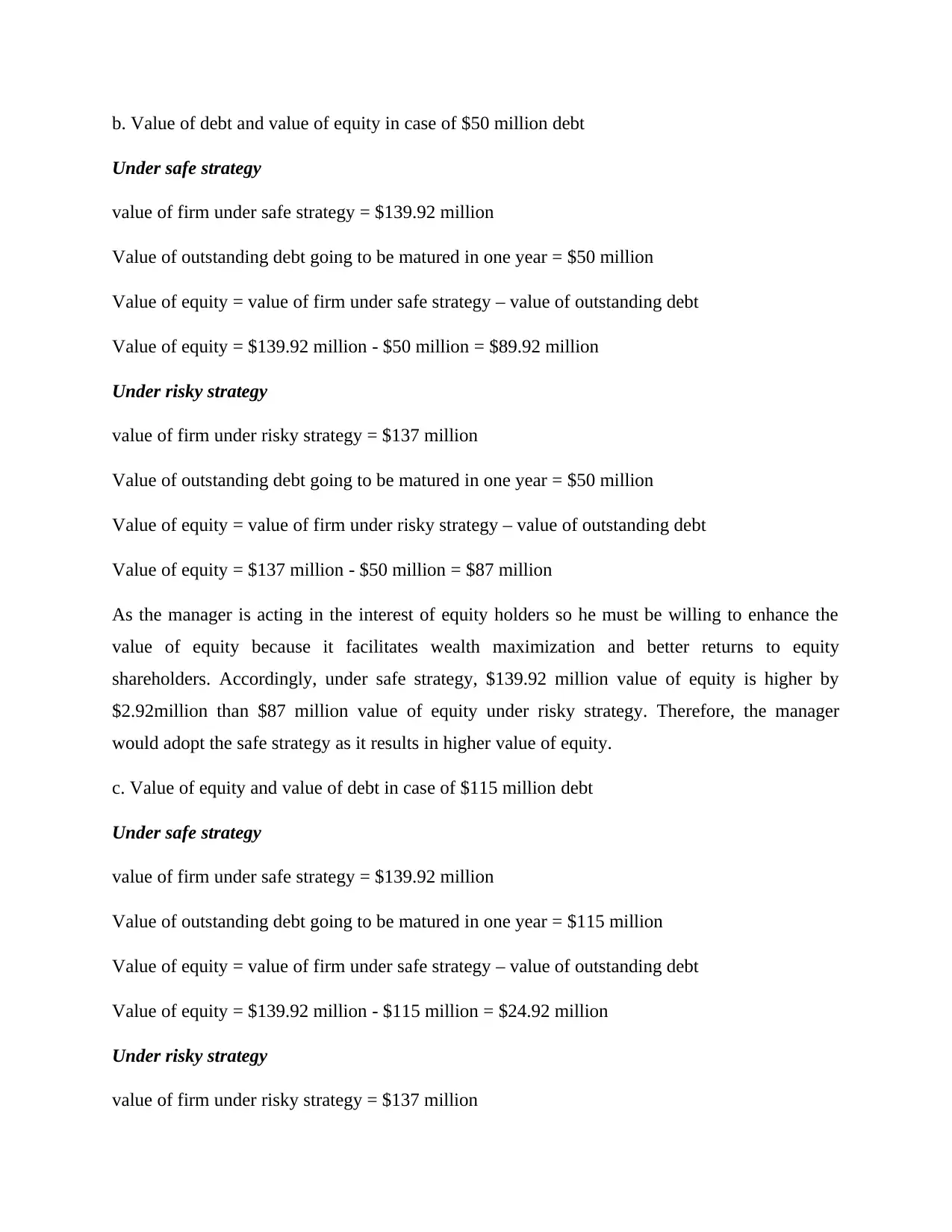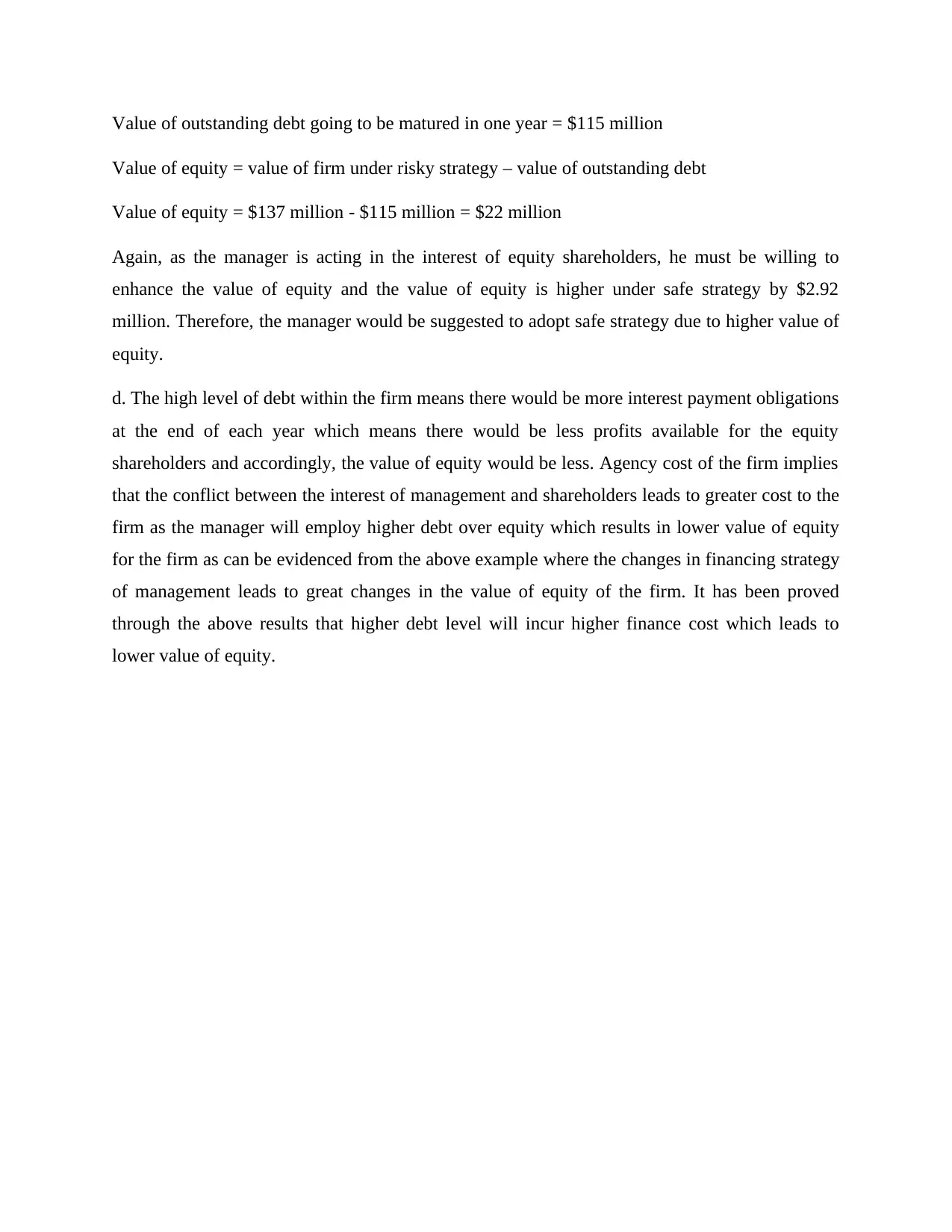Capital Structure, Takeovers, and Corporate Finance Strategies
VerifiedAdded on 2023/06/14
|4
|1168
|153
Homework Assignment
AI Summary
This assignment solution covers key concepts in corporate finance, including the free rider problem in takeovers, pecking order theory for capital structure, and factors influencing excess cash holdings. It analyzes the value of a firm under safe and risky strategies, considering different debt levels and their impact on equity value. The solution also discusses the implications of high debt levels and agency costs on equity value, providing a comprehensive overview of financial decision-making in a corporate setting. Desklib offers a variety of solved assignments and past papers for students seeking additional resources.

Question: 1
b. The problem can be referred to as a free rider problem in case of takeovers where the
transaction of takeover involves some costs or there is a requirement of effort on the part of the
raider which results in negative payoff of raider resulting from taking over of the firm.
Therefore, in such instance he is better off in not making tender offer in the first place.
Understanding through example
Suppose worth of a firm under current management = $10 per share while $20 per share to an
acquirer.
The acquirer will be offering $15 per share with the condition that he will get majority of shares.
The decisions of target shareholder for those holding small stake are:
In case of tender offer: $15 per share on closing of a deal otherwise $10 per share.
In case no tender offer: $20 per share worth on closing of a deal otherwise $10 per share.
What should shareholder holding small stake should do?
Small shareholders will not tender in case of the offer price being below the expected after
merger price. There is no effect of the individual’s decision to accept or reject the tender offer on
the success of the offer for shareholders having small stake.
There are many ways through which this problem could be sought, such as the following:
Two tier offers: Here the bidder undertakes to offer higher price for the first % of shares
and comparatively lower price for remaining proportion of shares. This would results in
increase in the likelihood of tender offer getting succeed and will benefit those who will
tender early.
Toehold acquisition by target: It is a profitable strategy in takeover where shares are
purchased before actual bidding takes place for the target.
Question: 3
In corporate finance, the theory of pecking order for capital structure states that the asymmetric
information raises the cost of financing. It states that companies generally undertakes to
prioritizes the available sources of financing from internal financing to equity financing where
b. The problem can be referred to as a free rider problem in case of takeovers where the
transaction of takeover involves some costs or there is a requirement of effort on the part of the
raider which results in negative payoff of raider resulting from taking over of the firm.
Therefore, in such instance he is better off in not making tender offer in the first place.
Understanding through example
Suppose worth of a firm under current management = $10 per share while $20 per share to an
acquirer.
The acquirer will be offering $15 per share with the condition that he will get majority of shares.
The decisions of target shareholder for those holding small stake are:
In case of tender offer: $15 per share on closing of a deal otherwise $10 per share.
In case no tender offer: $20 per share worth on closing of a deal otherwise $10 per share.
What should shareholder holding small stake should do?
Small shareholders will not tender in case of the offer price being below the expected after
merger price. There is no effect of the individual’s decision to accept or reject the tender offer on
the success of the offer for shareholders having small stake.
There are many ways through which this problem could be sought, such as the following:
Two tier offers: Here the bidder undertakes to offer higher price for the first % of shares
and comparatively lower price for remaining proportion of shares. This would results in
increase in the likelihood of tender offer getting succeed and will benefit those who will
tender early.
Toehold acquisition by target: It is a profitable strategy in takeover where shares are
purchased before actual bidding takes place for the target.
Question: 3
In corporate finance, the theory of pecking order for capital structure states that the asymmetric
information raises the cost of financing. It states that companies generally undertakes to
prioritizes the available sources of financing from internal financing to equity financing where
Paraphrase This Document
Need a fresh take? Get an instant paraphrase of this document with our AI Paraphraser

equity is considered to be the last resort. Accordingly, internal funds are used at the first place
and on its depletion, debts are employed and is issued till it is pretend to be prudent and at last
when there is no scope for further raising funds through debt, then equity sources are used.
The factors that are needed to be considered by companies while deciding to hold excess cash are
as follows:
Cost of debt: If the cost of debt is and causing financial risk for the business, then the
companies should not go for holding excess cash.
Short term rate of returns: If the rate of return offered on short term investment are higher
than then instead of holding cash it must be invested for generating better returns for the
company.
Question: 4
a. Value of firm under both safe and risky strategy
If the manager adopts the safe strategy
Cash flows Probabilities Expected cash flows
$64 million 1/3 = 0.33 $21.12 million
$150 million 1/3 = 0.33 $49.5 million
$210 million 1/3 = 0.33 $69.3 million
Value of firm under safe strategy $139.92 million
If the manager adopts the risky strategy
Cash flows Probabilities Expected cash flows
$64 million 0.5 $32 million
$150 million 0 $0 million
$210 million 0.5 $105 million
Value of firm under risky strategy $137 million
and on its depletion, debts are employed and is issued till it is pretend to be prudent and at last
when there is no scope for further raising funds through debt, then equity sources are used.
The factors that are needed to be considered by companies while deciding to hold excess cash are
as follows:
Cost of debt: If the cost of debt is and causing financial risk for the business, then the
companies should not go for holding excess cash.
Short term rate of returns: If the rate of return offered on short term investment are higher
than then instead of holding cash it must be invested for generating better returns for the
company.
Question: 4
a. Value of firm under both safe and risky strategy
If the manager adopts the safe strategy
Cash flows Probabilities Expected cash flows
$64 million 1/3 = 0.33 $21.12 million
$150 million 1/3 = 0.33 $49.5 million
$210 million 1/3 = 0.33 $69.3 million
Value of firm under safe strategy $139.92 million
If the manager adopts the risky strategy
Cash flows Probabilities Expected cash flows
$64 million 0.5 $32 million
$150 million 0 $0 million
$210 million 0.5 $105 million
Value of firm under risky strategy $137 million

b. Value of debt and value of equity in case of $50 million debt
Under safe strategy
value of firm under safe strategy = $139.92 million
Value of outstanding debt going to be matured in one year = $50 million
Value of equity = value of firm under safe strategy – value of outstanding debt
Value of equity = $139.92 million - $50 million = $89.92 million
Under risky strategy
value of firm under risky strategy = $137 million
Value of outstanding debt going to be matured in one year = $50 million
Value of equity = value of firm under risky strategy – value of outstanding debt
Value of equity = $137 million - $50 million = $87 million
As the manager is acting in the interest of equity holders so he must be willing to enhance the
value of equity because it facilitates wealth maximization and better returns to equity
shareholders. Accordingly, under safe strategy, $139.92 million value of equity is higher by
$2.92million than $87 million value of equity under risky strategy. Therefore, the manager
would adopt the safe strategy as it results in higher value of equity.
c. Value of equity and value of debt in case of $115 million debt
Under safe strategy
value of firm under safe strategy = $139.92 million
Value of outstanding debt going to be matured in one year = $115 million
Value of equity = value of firm under safe strategy – value of outstanding debt
Value of equity = $139.92 million - $115 million = $24.92 million
Under risky strategy
value of firm under risky strategy = $137 million
Under safe strategy
value of firm under safe strategy = $139.92 million
Value of outstanding debt going to be matured in one year = $50 million
Value of equity = value of firm under safe strategy – value of outstanding debt
Value of equity = $139.92 million - $50 million = $89.92 million
Under risky strategy
value of firm under risky strategy = $137 million
Value of outstanding debt going to be matured in one year = $50 million
Value of equity = value of firm under risky strategy – value of outstanding debt
Value of equity = $137 million - $50 million = $87 million
As the manager is acting in the interest of equity holders so he must be willing to enhance the
value of equity because it facilitates wealth maximization and better returns to equity
shareholders. Accordingly, under safe strategy, $139.92 million value of equity is higher by
$2.92million than $87 million value of equity under risky strategy. Therefore, the manager
would adopt the safe strategy as it results in higher value of equity.
c. Value of equity and value of debt in case of $115 million debt
Under safe strategy
value of firm under safe strategy = $139.92 million
Value of outstanding debt going to be matured in one year = $115 million
Value of equity = value of firm under safe strategy – value of outstanding debt
Value of equity = $139.92 million - $115 million = $24.92 million
Under risky strategy
value of firm under risky strategy = $137 million
⊘ This is a preview!⊘
Do you want full access?
Subscribe today to unlock all pages.

Trusted by 1+ million students worldwide

Value of outstanding debt going to be matured in one year = $115 million
Value of equity = value of firm under risky strategy – value of outstanding debt
Value of equity = $137 million - $115 million = $22 million
Again, as the manager is acting in the interest of equity shareholders, he must be willing to
enhance the value of equity and the value of equity is higher under safe strategy by $2.92
million. Therefore, the manager would be suggested to adopt safe strategy due to higher value of
equity.
d. The high level of debt within the firm means there would be more interest payment obligations
at the end of each year which means there would be less profits available for the equity
shareholders and accordingly, the value of equity would be less. Agency cost of the firm implies
that the conflict between the interest of management and shareholders leads to greater cost to the
firm as the manager will employ higher debt over equity which results in lower value of equity
for the firm as can be evidenced from the above example where the changes in financing strategy
of management leads to great changes in the value of equity of the firm. It has been proved
through the above results that higher debt level will incur higher finance cost which leads to
lower value of equity.
Value of equity = value of firm under risky strategy – value of outstanding debt
Value of equity = $137 million - $115 million = $22 million
Again, as the manager is acting in the interest of equity shareholders, he must be willing to
enhance the value of equity and the value of equity is higher under safe strategy by $2.92
million. Therefore, the manager would be suggested to adopt safe strategy due to higher value of
equity.
d. The high level of debt within the firm means there would be more interest payment obligations
at the end of each year which means there would be less profits available for the equity
shareholders and accordingly, the value of equity would be less. Agency cost of the firm implies
that the conflict between the interest of management and shareholders leads to greater cost to the
firm as the manager will employ higher debt over equity which results in lower value of equity
for the firm as can be evidenced from the above example where the changes in financing strategy
of management leads to great changes in the value of equity of the firm. It has been proved
through the above results that higher debt level will incur higher finance cost which leads to
lower value of equity.
1 out of 4
Related Documents
Your All-in-One AI-Powered Toolkit for Academic Success.
+13062052269
info@desklib.com
Available 24*7 on WhatsApp / Email
![[object Object]](/_next/static/media/star-bottom.7253800d.svg)
Unlock your academic potential
Copyright © 2020–2025 A2Z Services. All Rights Reserved. Developed and managed by ZUCOL.




